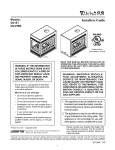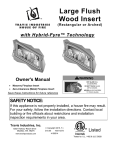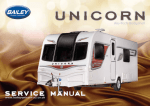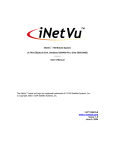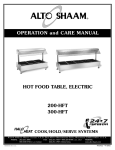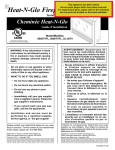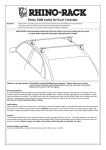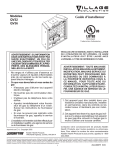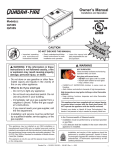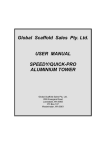Download Dodge 2004 Stratus Coupe Automobile User Manual
Transcript
Models: PIER-TVFL ST-42TVFL Installers Guide Underwriters Laboratories Listed WARNING: IF THE INFORMATION IN THESE INSTRUCTIONS IS NOT FOLLOWED EXACTLY, A FIRE OR EXPLOSION MAY RESULT CAUSING PROPERTY DAMAGE, PERSONAL INJURY, OR DEATH. - Do not store or use gasoline or other flammable vapors and liquids in the vicinity of this or any other appliance. - What to do if you smell gas • Do not try to light any appliance. • Do not touch any electrical switch. READ THIS MANUAL BEFORE INSTALLING OR OPERATING THIS APPLIANCE. THIS INSTALLERS GUIDE MUST BE LEFT WITH THE APPLIANCE FOR FUTURE REFERENCE. WARNING: IMPROPER INSTALLATION, ADJUSTMENT, ALTERATION, SERVICE OR MAINTENANCE CAN CAUSE INJURY OR PROPERTY DAMAGE. REFER TO THIS MANUAL. FOR ASSISTANCE OR ADDITIONAL INFORMATION CONSULT A QUALIFIED INSTALLER, SERVICE AGENCY, OR THE GAS SUPPLIER. • Do not use any phone in your building. • Immediately call your gas supplier from a neighbor's phone. Follow the gas supplier's instructions. • If you cannot reach your gas supplier, call the fire department. - Installation and service must be performed by a qualified installer, service agency, or the gas supplier. Please contact your Heat-N-Glo dealer with any questions or concerns. For the number of your nearest Heat-N-Glo dealer, please call 1-888-427-3973. Printed in U.S.A. Copyright 2004, Heat-N-Glo, a brand of Hearth & Home Technologies Inc. 20802 Kensington Boulevard, Lakeville, MN 55044 This product is covered by one or more of the following patents: (United States) 4,112,913; 4,408,594; 4,422,426; 4,424,792; 4,520,791; 4,793,322; 4,852,548; 4,875,464; 5,000,162; 5,016,609; 5,076,254 5,191,877; 5,218,953; 5,328,356; 5,429,495; 5,452,708; 5,542,407; 5,613,487; (Australia) 543790; 1 586383; (Canada) 1,123,296; 1,297,746; 2,195,264; (Mexico) 97-0457; (New Zealand) 200265; or other U.S. and foreign patents pending. 455-900G 2/04 SAFETY AND WARNING INFORMATION ! READ and UNDERSTAND all instructions carefully before starting the installation. FAILURE TO FOLLOW these installation instructions may result in a possible fire hazard and will void the warranty. ! Prior to the first firing of the fireplace, READ the Using Your Fireplace section of the Owners Guide. ! DO NOT USE this appliance if any part has been under water. Immediately CALL a qualified service technician to inspect the unit and to replace any part of the control system and any gas control which has been underwater. ! THIS UNIT IS NOT FOR USE WITH SOLID FUEL. ! 2 Installation and repair should be PERFORMED by a qualified service person. The appliance and venting system should be INSPECTED before initial use and at least annually by a professional service person. More frequent cleaning may be required due to excessive lint from carpeting, bedding material, etc. It is IMPERATIVE that the unit’s control compartment, burners, and circulating air passageways BE KEPT CLEAN to provide for adequate combustion and ventilation air. ! Always KEEP the appliance clear and free from combustible materials, gasoline, and other flammable vapors and liquids. ! NEVER OBSTRUCT the flow of combustion and ventilation air. Keep the front of the appliance CLEAR of all obstacles and materials for servicing and proper operations. ! Due to the high temperature, the appliance should be LOCATED out of traffic areas and away from furniture and draperies. Clothing or flammable material SHOULD NOT BE PLACED on or near the appliance. ! Children and adults should be ALERTED to the hazards of high surface temperature and should STAY AWAY to avoid burns or clothing ignition. Young children should be CAREFULLY SUPERVISED when they are in the same room as the appliance. ! These units MUST use one of the vent systems described in the Installing the Fireplace section of the Installers Guide. NO OTHER vent systems or components MAY BE USED. ! This gas fireplace and vent assembly MUST be vented directly to the outside and MUST NEVER be attached to a chimney serving a separate solid fuel burning appliance. Each gas appliance MUST USE a separate vent system. Common vent systems are PROHIBITED. ! INSPECT the external vent cap on a regular basis to make sure that no debris is interfering with the air flow. ! The glass door assembly MUST be in place and sealed, and the trim door assembly MUST be in place on the fireplace before the unit can be placed into safe operation. ! DO NOT OPERATE this appliance with the glass door removed, cracked, or broken. Replacement of the glass door should be performed by a licensed or qualified service person. DO NOT strike or slam the glass door. ! The glass door assembly SHALL ONLY be replaced as a complete unit, as supplied by the gas fireplace manufacturer. NO SUBSTITUTE material may be used. ! DO NOT USE abrasive cleaners on the glass door assembly. DO NOT ATTEMPT to clean the glass door when it is hot. ! Turn off the gas before servicing this appliance. It is recommended that a qualified service technician perform an appliance check-up at the beginning of each heating season. ! Any safety screen or guard removed for servicing must be replaced before operating this appliance. ! DO NOT place furniture or any other combustible household objects within 36 inches of the fireplace front. Safety and Warning Information ....................2 u Service Parts List ...............................................4 Section 1: Approvals and Codes ................ 10 Appliance Certification .......................................... 10 Installation Codes ................................................. 10 u High Altitude Installations ...................................... 10 Table of Contents Section 2: Getting Started .............................11 Introducing the Heat-N-Glo Gas Fireplaces ......... 11 Pre-installation Preparation .................................. 11 Section 3: Installing the Fireplace .............. 14 Step 1 Step 2 Step 3 Locating the Fireplace ............................ 14 Framing the Fireplace ............................ 15 Negative Pressure Make-up Air .............. 16 Step 4 Installing the Vent System ...................... 18 A. Vent System Approvals ...................... 18 u B. System Components ......................... 18 C. Bedroom Installation in Canada ........ 20 D. Vent Termination ................................ 20 Step 5 Positioning, Leveling, and Securing the Fireplace ........................... 21 Step 6 The Gas Control Systems ..................... 21 u Step 7 The Gas Supply Line .............................. 22 Step 8 Gas Pressure Requirements ................. 23 Step 9 Wiring the Fireplace ............................... 24 Step 10 Finishing ................................................. 25 Step 11 Installing Trim, Logs & Ember Material .. 27 Installing the Trim ................................... 27 Positioning the Logs ............................... 27 Placing the Ember Material .................... 28 Step 12 Before Lighting the Fireplace ................. 29 Step 13 Lighting the Fireplace ............................. 29 After the Installation .............................................. 29 Section 4: Maintaining and Servicing Your Fireplace ............................. 30 u = Contains updated information. 3 PIER-TVFL, PIER-TVFL-DSI Service Parts (NG, LP) Exploded Parts Diagram (GN, PL) Vue éclatée des pièces MANUFACTURING DATES SP Beginning: 8-97, Ending Date: ___ DSI Beginning: 8-97, Ending Date: 3-00 u 8 6 2 1 4 5 9 3 7 Log Assembly * Part number list on following page. * La liste des numéros de pièce se trouve à la page suivante. 4 (NG, LP) Service Parts List / Liste des pièces de rechange PIER-TVFL and PIER-TVFL-DSI IMPORTANT: THIS IS DATED INFORMATION. The most current information is located on your dealers VIP site. When ordering, supply serial and model numbers to ensure correct service parts. / IMPORTANT : L'information fournie dans cette brochure n'est valide que pendant une courte période. Les sites VIP des distributeurs disposent des renseignements les plus récents. Lors d'une commande, veuillez fournir les numéros de série et de modèles pour un remplacement adéquat des pièces. u ITEM / PIÈCE STANDING PILOT AND DSI IGNITION COMMON PARTS / UNE VEILLEUSE ET ALLUMAGE DSI PIÉCES COMMUNES 1 End Glass Assembly / verre 2 Glass Door Assembly / Porte en verre 3 3 Burner NG / Brûleur GN Burner LP / Brûleur PL SERIAL # / N° DE SÉRIE PART NUMBER / N° DE PIÈCE GLA-PTRC-E PRE 2-13-98 POST 2-13-98 GLA-PTRC GLA-PIER PRE 2824 501-176A 2824 TO 3003 501-173A POST 3004 501-272A PRE 1157 501-175A 1157 TO 1175 501-172A POST 1176 501-273A 4 Surround Side / Entourer le Côté 502-202 5 Base Refractory (Fiber) / Réfractaire Base SRV504-738-UM 5 Base Refractory (Metal) / Réfractaire Base 464-292 6 Refractory, Rear (Fiber) / Réfractaire SRV504-737-UM 6 Refractory, Rear (Metal) / Réfractaire 464-280 7 Log Set Assembly (sold as complete log set only) / Jeu de Bûches LOGS-MS 8 Hood / Hotte 455-322 9 Decorative Door / Porte décorative DF-356H STANDING PILOT IGNITION ONLY / ALLUMAGE UNE VEILLEUSE SEULEMENT Pilot Orifice NG / Orifice de veilleuse GN 446-505 Pilot Orifice LP / Orifice de veilleuse PL 446-517 Pilot Tube / Tube de veilleuse SRV485-301 Thermocouple / Thermocouple 446-511 Thermopile / Thermopile 060-512 Junction Box / Boîtier de dérivation 100-250A ACCESSORIES / ACCESSOIRES Remote Control Kit / Commande à distance RC-SMART-HNG Remote Control Kit / Commande à distance SMART-STAT-HNG Conversion Kit NG / Module de conversion GN Conversion Kit LP / Module de conversion PL PRE 3003 NGK-PTVFLB POST 3004 PRE 1175 NGK-PTVFLMS NGK-PTVFLMS-DSI LPK-PTVFLB POST 1176 LPK-PTRCMS LPK-PTVFLMS-DSI Also see additional pages for DSI and Standing Pilot service part numbers. 5 ST-42TVFL, ST-42TVFL-DSI Service Parts (NG, LP) Exploded Parts Diagram (GN, PL) Vue éclatée des pièces MANUFACTURING DATES SP Beginning: 8-97, Ending Date: ___ DSI Beginning: 8-97, Ending Date: 8-02 u 1 3 5 1 5 7 4 2 6 Log Assembly * Part number list on following page. * La liste des numéros de pièce se trouve à la page suivante. 6 (NG, LP) Service Parts List / Liste des pièces de rechange ST-42TVFL and ST-42TVFL-DSI IMPORTANT: THIS IS DATED INFORMATION. The most current information is located on your dealers VIP site. When ordering, supply serial and model numbers to ensure correct service parts. / IMPORTANT : L'information fournie dans cette brochure n'est valide que pendant une courte période. Les sites VIP des distributeurs disposent des renseignements les plus récents. Lors d'une commande, veuillez fournir les numéros de série et de modèles pour un remplacement adéquat des pièces. u ITEM / PIÈCE 1 2 2 STANDING PILOT AND DSI IGNITION COMMON PARTS / UNE VEILLEUSE ET ALLUMAGE DSI PIÉCES COMMUNES Glass Door Assembly / Porte en verre Burner NG / Brûleur GN Burner LP / Brûleur PL SERIAL # / N° DE SÉRIE PART NUMBER / N° DE PIÈCE PRE 2-13-98 POST 2-13-98 GLA-PTRC GLA-PIER PRE 5292 501-176A 5292 TO 5997 501-173A POST 5998 501-272A PRE 1439 501-175A 1439 TO 1517 501-172A POST 1518 501-273A 3 Hood / Hotte 455-322 4 Base Refractory (Fiber) / Réfractaire Base SRV504-738-UM 4 Base Refractory (Metal) / Réfractaire Base 464-292 5 Refractory, Rear (Fiber) / Réfractaire SRV504-737-UM 5 Refractory, Rear (Metal) / Réfractaire 464-280 6 Log Set Assembly (sold as complete log set only) / Jeu de Bûches LOGS-MS 7 Decorative Door / Porte décorative DF-36H STANDING PILOT IGNITION ONLY / ALLUMAGE UNE VEILLEUSE SEULEMENT Pilot Orifice NG / Orifice de veilleuse GN 446-505 Pilot Orifice LP / Orifice de veilleuse PL 446-517 Pilot Tube / Tube de veilleuse SRV485-301 Thermocouple / Thermocouple 446-511 Thermopile / Thermopile 060-512 Junction Box / Boîtier de dérivation 100-250A ACCESSORIES / ACCESSOIRES Remote Control Kit / Commande à distance RC-SMART-HNG Remote Control Kit / Commande à distance SMART-STAT-HNG PRE 5997 Conversion Kit NG / Module de conversion GN POST 5998 PRE 1517 Conversion Kit LP / Module de conversion PL POST 1518 NGK-PTVFLB NGK-PTVFLMS NGK-PTVFLMS-DSI LPK-PTVFLB LPK-PTRCMS LPK-PTVFLMS-DSI 7 Also see additional pages for DSI and Standing Pilot service part numbers. 7 PIER-TVFL, ST-42TVFL Service Parts (NG, LP) Exploded Parts Diagram (GN, PL) Vue éclatée des pièces Beginning Manufacturing Date: 10-97 Ending Manufacturing Date: ______ u Standing Pilot Ignition Valve Assembly 12 4 13 10 9 5 7 1 11 2 8 3 u ITEM / PIÈCE 6 DESCRIPTION SERIAL # / N° DE SÉRIE PART NUMBER / N° DE PIÈCE 1 Valve NG / Valve GN 060-522 1 Valve LP / Valve PL 060-523 2 ON/OFF Rocker Switch / Interrupteur à bascule MARCHE/ARRÊT 060-521A 3 Piezo Ignitor / Allumeur piézo 418-513 4 Pilot Assembly NG / Module de veilleuse GN 485-510A 4 Pilot Assembly LP / Module de veilleuse PL 485-511A 5 Valve Bracket / Parenthèse de Valve 501-115 6 Wire Assembly Piggyback / Le Ferroutage d'Assemblée de fil 049-552A 7 Flex Ball Valve Assembly / Fléchir l'Assemblée de Soupape de Balle 302-320A 8 Burner Tube / Tube de brûleur 501-302 9 High Temp Limit Switch / Interrupteur de détection thermique 066-531 10 Drop-In Plate / Tombe-dans Plaque 501-151 11 Valve Bracket Plate / La Plaque de Crochet de soupape 501-215 12 Burner Assembly / Brûleur See previous pages for part numbers 13 80" Wire Assembly / Module de fil 522-501A Orifice NG (#33B) / Orifice GN (#33B) 455-800 Orifice LP (#48B) / Orifice PL (#48B) 042-800 8 Service Parts PIER-TVFL-DSI, ST-42TVFL-DSI (NG, LP) Exploded Parts Diagram (GN, PL) Vue éclatée des pièces u MANUFACTURING DATES ST-42TVFL-DSI Beginning: 8-97, Ending Date: 8-02 PIER-TVFL-DSI Beginning: 8-97, Ending Date: 3-00 9 Direct Spark Ignition Valve Assembly 8 4 12 7 5 10 11 3 6 1 2 u ITEM / PIÈCE DESCRIPTION SERIAL # / N° DE SÉRIE PART NUMBER / N° DE PIÈCE 1 Junction Box / Boîtier de dérivation 100-254A 2 ON/OFF Rocker Switch / Interrupteur à bascule MARCHE/ARRÊT 060-511 3 Burner Tube / Tube de brûleur 501-302 4 Orifice Assembly NG (#31B) / Assemblée d'Orifice GN (#31B) 455-800 4 Orifice Assembly LP (#48B) / Assemblée d'Orifice PL (#48B) 042-800 5 Valve Bracket / Parenthèse de Valve 501-115 6 Valve NG / Valve GN 492-500 6 Valve LP / Valve PL 492-501 7 Flex Ball Valve Assembly / Fléchir l'Assemblée de Soupape de Balle 302-320A 8 High Temp Limit Switch / Interrupteur de détection thermique 066-531 9 Burner Assembly NG / Brûleur GN See previous pages for part numbers 10 Drop-In Plate / Tombe-dans Plaque 501-151 11 Valve Support Bracket / Le Crochet de Soutien de soupape 501-215 12 Module / Module 501-592 Ignitor / Allumeur 501-591 9 1 Approvals and Codes Approval Listings and Codes Appliance Certification The Heat-N-Glo fireplace models discussed in this Installers Guide have been tested to certification standards and listed by the applicable laboratories. MODEL LABORATORY TYPE Pier-TVFL ST-42TVFL Underwriters Laboratories B- Vent Decorative CERTIFICATION STANDARD ANSI Z21.50•CGA2.22 Installation Codes The fireplace installation must conform to local codes. Before installing the fireplace, consult the local building code agency to ensure that you are in compliance with all applicable codes, including permits and inspections. In the absence of local codes, the fireplace installation must conform to the National Fuel Gas Code ANSI Z223.1 (in the United States) or the CAN/CGAB149 Installation Codes (in Canada). The appliance must be electrically grounded in accordance with local codes or, in the absence of local codes with the National Electric Code ANSI/NFPA No. 70 (in the United States), or to the CSA C22.1 Canadian Electric Code (in Canada). This model (natural gas and propane) can be installed in a bedroom (in the United States) which has a total volume of unconfined space appropriate to the particular installation. Refer to the National Fuel Gas Code ANSI Z223.1/NFPA54 (current edition). The Uniform Mechanical Code - (current edition), and local Building Officials for the options allowed in obtaining an effective bedroom volume of unconfined space. This model (natural gas and propane) can be installed in a bedroom (in Canada) if a thermostat (Model WH-STAT) is installed with the unit. Consult local code authorities. Detailed installation instructions for Model WH-STAT are included with the kit. High Altitude Installations u U.L. Listed gas appliances are tested and approved without requiring changes for elevations from 0 to 2,000 feet in the U. S. A. and in Canada. When installing this appliance at an elevation above 2,000 feet, it may be necessary to decrease the input rating by changing the existing burner orifice to a smaller size. Input rate should be reduced by 4% for each 1000 feet above a 2000 foot elevation in the U.S.A. or 10% for elevations between 2000 and 4500 feet in Canada. If the heating value of the gas has been reduced, these rules do not apply. To identify the proper orifice size, check with the local gas utility. If installing this appliance at an elevation above 4,500 feet (in Canada), check with local authorities. Consult your local gas utility for assistance in determining the proper orifice for your location. 10 Heat-N-Glo Quality Systems registered by SGS ICS Introducing the Heat-N-Glo Gas Fireplaces Heat-N-Glo B-type vent gas fireplaces are designed to operate with all exhaust gases expelled to the outside of the building. The information contained in this Installers Guide, unless noted otherwise, applies to all models and gas control systems. Gas fireplace diagrams, including the dimensions, are shown in this section. Pre-installation Preparation This gas fireplace and its components are tested and safe when installed in accordance with this Installers Guide. Report to your dealer any parts damaged in shipment, particularly the condition of the glass. Do not install any unit with damaged, incomplete, or substitute parts. 2 Getting Started The vent system components are shipped in separate packages. The gas logs are packed separately and must be field installed. Read all of the instructions before starting the installation. Follow these instructions carefully during the installation to ensure maximum safety and benefit. Failure to follow these instructions will void the owner’s warranty and may present a fire hazard. The Heat-N-Glo Warranty will be voided by, and HeatN-Glo disclaims any responsibility for, the following actions: • Installation of any damaged fireplace or vent system component. • Modification of the fireplace or vent system. • Installation other than as instructed by Heat-N-Glo. • Improper positioning of the gas logs or the glass door. • Installation and/or use of any component part not manufactured and approved by Heat-N-Glo not withstanding any independent testing laboratory or other party approval of such component part or accessory. ANY SUCH ACTION MAY POSSIBLY CAUSE A FIRE HAZARD. 11 When planning a fireplace installation, it’s necessary to determine: • Where the unit is to be installed. • The vent system configuration to be used. • Gas supply piping. • Electrical wiring. • Framing and finishing details. • Whether optional accessories—devices such as a fan, wall switch, or remote control—are desired. If the fireplace is to be installed on carpeting or tile, or on any combustible material other than wood flooring, the fireplace should be installed on a metal or wood panel that extends the full width and depth of the fireplace. 21 5/8 (551mm) 24 1/4 (616mm) 12 1/8 (308mm) VENT COLLAR ELECTRICAL ACCESS GAS LINE ACCESS 41 (1043mm) 36 7/8 (937mm) 24 1/4 (616mm) 36 7/8 (937mm) 40 3/4 (1035mm) LEFT SIDE TOP STANDOFFS RATING PLATES & LABELS 12 GAS LINE ACCESS Figure 1. Diagram of the Pier-TVFL GAS CONTROL VALVE 4 (102mm) 4 (102mm) FRONT 1/2" STANDOFFS ELECTRICAL ACCESS 2 1/2 (64mm) 2 1/2 (64mm) RIGHT SIDE 21 5/8 (549mm) 24 1/4 (616mm) 12 1/8 (308mm) VENT COLLAR ELECTRICAL ACCESS GAS LINE ACCESS 41 (1042mm) 36 7/8 (937mm) 2 1/2 (64mm) 2 1/2 (64mm) 36 1/8 (918mm) 4 (102mm) 43 (1093mm) 4 (102mm) LEFT SIDE FRONT RIGHT SIDE TOP STANDOFFS ELECTRICAL ACCESS 1/2" STANDOFFS RATING PLATE & LABELS GAS LINE ACCESS GAS CONTROL VALVE Figure 2. Diagram of the ST-42TVFL 13 Step 1 Locating the Fireplace 3 The diagram below shows space and clearance requirements for locating a fireplace within a room. GLASS GLASS 36" GLASS PIER-TVFL Installing the Fireplace 36 " TOP VIEW 36" ST-42TVFL GLASS 1" GLASS Figure 3. Fireplace Locations and Space Requirements Clearance Requirements The top, back, and sides of the fireplace are defined by stand-offs. Minimum Clearances from the Fireplace to Combustible Materials Glass Sides 36 inches (914 mm) Floor 0 Back of Fireplace Metal Ends of Fireplace Top of Fireplace Ceiling* 1/2 inch (13 mm) 1/2 inch (13 mm) 4-1/2 inches (89 mm) 31 inches (787 mm) * The clearance to the ceiling is measured from the top of the unit, excluding any standoffs (see Figure 13). The minimum clearance to a perpendicular wall extending past the face of the fireplace is one inch (25 mm). The metal end(s) of these fireplaces may NOT be recessed into combustible construction. 14 Minimum Clearances from the B-Type Vent Pipe to Combustible Materials is 1 inch (25 mm) all around the pipe. Step 2 Framing the Fireplace Fireplace framing can be built before or after the fireplace is set in place. Framing should be positioned to accommodate wall coverings and fireplace facing material. The diagram below shows framing reference dimensions. CAUTION MEASURE FIREPLACE DIMENSIONS, AND VERIFY FRAMING METHODS AND WALL COVERING DETAILS, BEFORE FRAMING CONSTRUCTION BEGINS. PIER-TVFL ST-42TVFL FRAMING HEADERS C C B A A B MODEL PIER ST-42TVFL A 40 1/4 44 B 23 1/4 23 1/4 C 41 1/2 41 1/2 Figure 5. Framing Dimensions 15 Step 3 Negative Pressure Make-up Air Negative Pressure warning: When negative pressure is present, an atmospherically vented fireplace (with a draft hood) may not function properly and it may down draft. In the case of a gas appliance, spillage of the combustion gases may occur. This may create a dangerous carbon monoxide situation in the house. The causes of negative pressure to a house can include the following: • Stack effect in the building. • Exhaust only appliances (mechanically and atmospherically vented). • Inadequate make-up air (which is increasingly more prevalent in new construction). NOTE: This fireplace will operate correctly only if adequate ventilation is provided to allow proper draft to the fireplace system. Heat-N-Glo assumes no responsibility for the improper performance of the fireplace system caused by inadequate draft due to environmental conditions, down drafts, tight sealing construction of the structure, or mechanical exhausting devices which create a negative air pressure within the structure where the fireplace is located. It is recommended that all natural venting non-air tight gas fireplaces have outside air connected to them. It is also recommended that the building be mechanically or passively balanced to allow atmospherically vented appliances, such as top vented gas fireplaces with draft hoods, to draft properly. If the home experiences negative pressure or is likely to experience negative pressure, connection to an outside air source is mandatory. Installing Optional Outside Make-up Air: This unit is equipped to accept outside air. By using outside makeup air, the amount of room air used for combustion will be reduced. It is recommended that an AK-TV air kit be used with this appliance. ! WARNING: IN A NEGATIVE PRESSURE CONDITION (LIKELY TO OCCUR IN NEW HOMES THAT DO NOT HAVE ADEQUATE MAKE-UP AIR) THE OUTSIDE AIR KIT MUST BE INSTALLED TO OBTAIN PROPER PERFORMANCE AND TO HELP PREVENT SPILLAGE OF COMBUSTION GASES. A 4-inch damper assembly (found in AK-TV Kit) must be installed to the fireplace. See Figure 5. Attach the damper assembly to the outer wrap of the fireplace using sheetmetal screws 16 Detailed installation instructions for Model AK-TV Outside Air kit are found in the kit. Air Damper Before lighting the burner, open the damper plate by sliding the air damper rod, located by the gas valve, towards you. DUCT COLLAR DAMPER ASSEMBLY Figure 5. Make-up Air 17 Step 4 Installing the Vent System A. Vent System Approvals These fireplaces are approved to use 6-inch (152mm) diameter B-type vent. B-type vent must be used when the vent system is within combustible construction. These models may also use single wall rigid or flexible gas vent IF and ONLY IF the vent system is installed within non-combustible construction such as a masonry chimney. The same diameters noted above for B-type vent must be used for single-wall vent. See Figure 6. The flame and ember appearance may vary based on the type of fuel burned and the venting configuration used. B. System Components. Vent System Configuration MAXIMUM TOTAL HORIZONTAL RUN = 17 FT. MINIMUM TOTAL VERTICAL RISE = 10 FT. MAXIMUM NO. of ELBOWS: 2 - 90o or 4 - 45o Plan and install the vent system using the parameters shown above. ! WARNING: YOU MUST NOT EXCEED THESE PARAMETERS. Connect a B-Type vent component to the flue outlet collar. Look at top inside of the firebox to check that the vent pipe is attached to the unit. NOTE: It is required to first attach a straight section of vent to the unit before attaching a 90 o elbow. Avoid using elbows in the vent system if possible. A 90-degree elbow CANNOT be attached directly to u the unit. A 45o elbow can be attached directly to the unit. It must have a straight section of pipe attached to it for a MINIMUM of 4-feet before a second 450 elbow to a horizontal run (see Figure 6). The horizontal component of the vent system must not exceed a MAXIMUM of 17-feet. The vertical component of the vent system must exceed a MINIMUM of 10-feet. Two 450 elbows to vertical can be used at any length within the 17-feet maximum horizontal component. Continue to add vent components, until the vent run is completed. ! WARNING: YOU MUST NOT EXCEED A TOTAL MAXIMUM HORIZONTAL RUN OF 17 FEET FOR THE ENTIRE VENT SYSTEM. NOTE: The vent termination must be in a vertical position and the termination cap must be listed for the vent pipe used. 18 Consult local building code officials and codes for proper vent system installations. 4 FT. MINIMUM MAXIMUM HORIZONTAL RUN 17 FT. MAXIMUM 10 FT. MINIMUM 4 FT MINIMUM Figure 6. Vent System Attachment ! WARNING: THIS GAS FIREPLACE MUST NEVER BE VENTED BY CONNECTING TO A CHIMNEY FLUE SERVING A SEPARATE SOLID FUEL BURNING APPLIANCE. 19 C. Bedroom Installation in Canada This model MUST NOT be vented into a vent system installed exterior to a building. The part of the vent system above the roof line can be exterior to the building. D. Vent Termination ! WARNING: MAJOR U.S. BUILDING CODES SPECIFY MINIMUM CHIMNEY AND/OR VENT HEIGHT ABOVE THE ROOF TOP. THESE MINIMUM HEIGHTS ARE NECESSARY IN THE INTEREST OF SAFETY. FIGURE 7 AND TABLE SHOW MINIMUM HEIGHTS, PROVIDED THE TERMINATION CAP IS AT LEAST 8-FEET FROM A VERTICAL WALL. NOTE: THERE SHOULD BE A 5 FOOT (60”) MINIMUM CLEARANCE T O AN UNVENTILATED VINYL CLAD SOFFIT. VENT CAP LOWEST DISCHARGE OPENING X 12 ROOF PITCH IS X/12 H (MIN.)-MINIMUM HEIGHT FROM ROOF TO LOWEST DISCHARGE OPENING ROOF PITCH H (MIN.) FT. FLAT TO 6/12 6/12 TO 7/12 OVER 7/12 TO 8/12 OVER 8/12 TO 9/12 OVER 9/12 TO 10/12 OVER 10/12 TO 11/12 OVER 11/12 TO 12/12 OVER 12/12 TO 14/12 OVER 14/12 TO 16/12 OVER 16/12 TO 18/12 OVER 18/12 TO 20/12 OVER 20/12 TO 21/12 1.0 1.25 1.5 2.0 2.5 3.25 4.0 5.0 6.0 7.0 7.5 8.0 Figure 7. Vent Termination 20 Step 5 Positioning, Leveling, and Securing the Fireplace The diagram below shows how to properly position, level, and secure the fireplace. 1. Place the fireplace into position. 2. Level the fireplace from side to side and from front to back. 3. Shim the fireplace with non-combustible material, such as sheet metal, as necessary. 4. Secure the fireplace to the framing by nailing or screwing. NAILING TABS AT BASE OF FIREPLACE. Figure 8. Proper Positioning, Leveling, and Securing of a Fireplace Step 6 The Gas Control Systems WARNING: THIS UNIT IS NOT FOR USE WITH SOLID FUEL. ! Direct Spark Ignition (DSI) or Standing Pilot (Millivolt) gas control systems are used in these models. Standing Pilot Ignition System This system includes millivolt control valve, standing pilot, thermopile/thermocouple flame sensor, and piezo ignitor. ! WARNING 110-120 VAC MUST NEVER BE CONNECTED TO A CONTROL VALVE IN A MILLIVOLT SYSTEM. Direct Spark Ignition (DSI) System This system includes a 110V control valve, electronic module (with internal transformer) and spark ignitor/ flame sensor. ! WARNING: CONTINUOUS 110 -120 VAC SERVICE MUST BE DIRECTLY WIRED TO THE FIREPLACE JUNCTION BOX IN A DSI SYSTEM. 21 STANDING PILOT DSI IGNITION Figure 9. Gas Controls Systems Step 7 The Gas Supply Line NOTE: Have the gas supply line installed in accordance with local building codes by a qualified installer approved and/or licensed as required by the locality. (In the Commonwealth of u Massachusetts installation must be performed by a licensed plumber or gas fitter). NOTE: Before the first firing of the fireplace, the gas supply line should be purged of any trapped air. NOTE: Consult local building codes to properly size the gas supply line leading to the 1/2 inch (13 mm) hook-up at the unit. This gas fireplace is designed to accept a 1/2 inch (13 mm) gas supply line. To install the gas supply line: • A listed (and Commonwealth of Massachusetts ap- u proved) 1/2 inch (13mm) tee-handle manual shutoff valve and a listed flexible gas connector are connected to the 1/2 inch (13mm) inlet of the control valve. NOTE: If substituting for these components, please consult local codes for compliance. • The gas line may be run from either side of the fireplace provided the hole in the outer wrap does not exceed 2 inches in diameter and it does not penetrate the airtight firebox. • The gap between the supply piping and gas access hole can be plugged with non-combustible insulation to prevent cold air infiltration. • Locate the gas line access hole in the outer casing of the fireplace. • Remove decorative door by lifting up away to gain access to the gas control and shut-off valve, insert the gas supply line through the gas line hole, and connect it to the shut-off valve. • When attaching the pipe, support the control so that the lines are not bent or torn. • After the gas line installation is complete, all connec- u tions must be tightened and checked for leaks with a commercially available, non-corrosive leak check solution. Be sure to rinse off all leak check solution following testing. 22 ! WARNING: DO NOT USE AN OPEN FLAME TO CHECK FOR GAS LEAKS. • At the gas line access hole, use insulation to repack the space around the gas pipe. • Insert insulation from the outside of the fireplace and pack the insulation tightly to totally seal between the pipe and the outer casing. The gas line should be installed by a qualified service technician. USE A WRENCH ON SHUT-OFF VALVE WHEN TIGHTENING GAS LINE MANUAL SHUT-OFF VALVE GAS VALVE GAS LINE ACCESS FLEX CONNECTOR Figure 10. Gas Supply Line Step 8 Gas Pressure Requirements Pressure requirements for Heat-N-Glo gas fireplaces are shown in the table below. Pressure Natural Gas Propane Minimum Inlet Pressure 5.0 inches w.c. 11.0 inches w.c. Maximum Inlet Gas Pressure 14.0 inches w.c. 14.0 inches w.c. Manifold Pressure 3.5 inches w.c. 10.0 inches w.c. A one-eighth (1/8) inch (3 mm) N.P.T. plugged tapping is provided on the inlet and outlet side of the gas control for a test gauge connection to measure the manifold pressure. The fireplace and its individual shut-off valve must be disconnected from the gas supply piping system during any pressure testing of the system at test pressures in excess of one-half (1/2) psig (3.5 kPa). The fireplace must be isolated from the gas supply piping system by closing its individual shut-off valve during any pressure testing of the gas supply piping system at test pressures equal to or less than one-half (1/2) psig (3.5 kPa). 23 Step 9 Wiring the Fireplace NOTE: Electrical wiring must be installed by a licensed electrician. Caution: Disconnect remote controls if you are absent for extended time periods. This will prevent accidental fireplace operation. For Standing Pilot Ignition Wiring Appliance Requirements • This appliance DOES NOT require 110-120 VAC to operate. ! WARNING DO NOT CONNECT 110-120 VAC TO THE GAS CONTROL VALVE WALL SWITCH OR THE APPLIANCE WILL MALFUNCTION AND THE VALVE WILL BE DESTROYED. Optional Accessories Optional remote control kits require that 110-120 VAC be wired to the factory installed junction box before the fireplace is permanently installed. Wall Switch Position the wall switch in the desired position on a wall. Run a maximum of 25 feet (7.8 m) or less length of 18 A.W.G. minimum wire and connect it to the fireplace ON/OFF switch pigtails. ! CAUTION WARNING DO NOT CONNECT 110-120 VAC TO THE WALL SWITCH OR THE CONTROL VALVE WILL BE DESTROYED. LABEL ALL WIRES PRIOR TO DISCONNECTION WHEN SERVICING CONTROLS. WIRING ERRORS CAN CAUSE IMPROPER AND DANGEROUS OPERATION. VERIFY PROPER OPERATION AFTER SERVICING. BLACK L2 BLACK L1 HI-TEMP LIMIT SWITCH REMOTE SWITCH PIGTAIL GAS VALVE ON OFF WHITE T2 ON/OFF SWITCH RED T1 THERMOPILE THERMOCOUPLE 24 BLACK S1 Figure 11. Standing Pilot Ignition Wiring Diagram OPTIONAL WALL SWITCH, THERMOSTAT OR REMOTE OPTIONAL REMOTE, HI TEMP L2 WALL SWITCH LIMIT SWITCH OR THERMOSTAT (NEUTRAL) (ON CERTIFIED UNITS ONLY) 100-254A OPTIONAL JUNCTION L1 FAN (HOT) BOX SWITCHES 120 VAC 476-500 DSI CONTROL VALVE 459-591 IGNITOR WHITE ON/OFF REM FAN BLUE GROUND ORANGE BLACK 501-592 DSI MODULE WHITE YELLOW GROUND TO FIREPLACE CHASSIS GREEN BLUE WHITE BLACK FLAME SENSOR/SPARKER HI-TEMP LIMIT SWITCH IGNITION MODULE ON/OFF SWITCH GAS VALVE REMOTE OUTLET FAN OUTLET NEUTRAL CONNECTORS HOT GROUND Figure 12. Direct Spark Ignition (DSI) Wiring Diagram For Direct Spark Ignition (DSI) Wiring Appliance Requirements This appliance requires that 110-120 VAC be wired to the factory installed junction box. Maintain correct polarity when wiring the junction box. Optional Accessories Optional remote control kits require that 110-120 VAC be wired to the fireplace junction box. Wall Switch Position the wall switch in the desired position on a wall. Run a maximum of 25 feet (7.8 m) or less of 16 A.W.G. minimum wire and connect it to the fireplace ON/OFF switch pigtails. CAUTION LABEL ALL WIRES PRIOR TO DISCONNECTION WHEN SERVICING CONTROLS. WIRING ERRORS CAN CAUSE IMPROPER AND DANGEROUS OPERATION. VERIFY PROPER OPERATION AFTER SERVICING. 25 Step 10 Finishing The following diagram shows the minimum vertical and corresponding maximum horizontal dimensions of fireplace mantels or other combustible projections above the top front edge of the fireplace. See Figures 3 and 4 for other fireplace clearances. Only noncombustible materials may be used to cover the black fireplace front. CEILING DRY WALL 31” 12" TOP FRONT EDGE OF FIREPLACE 1 1/2" MINIMUM Figure 13. Minimum Vertical and Maximum Horizontal Dimensions of Combustibles above Fireplace ! CAUTION 26 WARNING WHEN FINISHING THE FIREPLACE, NEVER OBSTRUCT OR MODIFY THE AIR INLET/OUTLET GRILLES IN ANY MANNER. IF JOINTS BETWEEN THE FINISHED WALLS AND THE FIREPLACE SURROUND (TOP AND SIDES) ARE SEALED, A 300° F. MINIMUM SEALANT MATERIAL MUST BE USED. THESE JOINTS ARE NOT REQUIRED TO BE SEALED. ONLY NONCOMBUSTIBLE MATERIAL (USING 300° F. MINIMUM ADHESIVE, IF NEEDED) CAN BE APPLIED AS FACING TO THE FIREPLACE SURROUND. SEE THE FOLLOWING DIAGRAM ST-42TVFL 1. Apply only noncombustible facing material to the fireplace surround. TOP EDGE 1/2" SIDE EDGE 1/2" GAP BOTH ENDS TOP EDGE 1/2" SIDE EDGE 1/2" GAP PIER-TVFL Figure 14. Sealant Material Hearth Extensions A hearth extension may be desirable for aesthetic reasons. However, ANSI or CAN/CGA testing standards do not require hearth extensions for gas fireplace appliances. Step 11 Installing Trim, Logs, and Ember Material Installing the Trim Combustible materials may be brought up to the specified clearances on the side and top front edges of the fireplace, but MUST NEVER overlap onto the front face. The joints between the finished wall and the fireplace top and sides can only be sealed with a 300° F. (149° C) minimum sealant. ! WARNING: WHEN FINISHING THE FIREPLACE, NEVER OBSTRUCT OR MODIFY THE AIR INLET/OUTLET GRILLES IN ANY MANNER. Install optional marble and brass trim surround kits as desired. Marble, brass, brick, tile, or other noncombustible materials can be used to cover up the gap between the sheet rock and the fireplace. Do not obstruct or modify the air inlet/outlet grilles. When overlapping on both sides, leave enough space so that the glass door can be removed. Positioning the Logs If the gas logs have been factory installed they should not need to be positioned. If the logs have been packaged separately, refer to the installation instructions that accompany the logs. Save the log instructions with this manual. If sooting occurs, the logs might need to be repositioned slightly to avoid excessive flame impingement. 27 GLASS SPECIFICATIONS: LARGE GLASS: TEMPERED SMALL GLASS: TEMPERED Heat-N-Glo fireplaces manufactured with tempered glass may be installed in hazardous locations such as bathtub enclosures as defined by the CPSC. The tempered glass has been tested and certified to the requirements of ANSI Z97.1-1984 and CPSC 16 CFR 1202. (Safety Glazing Certification Council SGCC # 1595 and 1597. Architectural Testing, Inc. Reports 02-31919.01 and 02-31917.01.) This statement is in compliance with CPSC 16 CFR Section 1201.5 “Certification and labeling requirements” which refers to 15 USC 2063 stating “…Such certificate shall accompany the product or shall otherwise be furnished to any distributor or retailer to whom the product is delivered.” Some local building codes require the use of tempered glass with permanent marking in such locations. Glass meeting this requirement is available from the factory. Please contact your dealer or distributor to order. Placing the Ember Material Ember material is shipped with this gas fireplace. The bag labeled Golden Ember (GE-93) is flame colorant material. The bag labeled Glowing Ember (050-721) is standard glowing ember material. To place the ember material: • Remove the wing nuts and glass clips or tension springs around the glass door. Remove the glass door from the unit. • Save the remaining ember materials for use during fireplace servicing. The bag of embers provided is sufficient for 3 to 5 applications. • Place dime size pieces of ember material about 1/2 inch apart near port holes in burner top. Do NOT press embers into burner ports. Cover the top of the burner with a single layer of ember material. For best performance do NOT place embers on the ports at the rear of the burner. • Replace the wing nut, glass clips and screws. • Replace the glass door and a front trim door on the unit. • Hand tighten the wing nut. 28 Figure 15. Placement of the Ember Material Step 12 Before Lighting the Fireplace Before lighting the fireplace, be sure to do the following: Remove all paperwork and documents from underneath the fireplace. Review safety warnings and cautions • Read the Safety and Warning Information section at the beginning of this Installers Guide. Double-check for gas leaks • Before lighting the fireplace, double-check the unit for possible gas leaks. Double-check vent terminations and front grilles for obstructions. • Before lighting the fireplace, double-check the unit for possible obstructions that could be blocking the vent terminations or the front grilles. Double-check for faulty components • Any component that is found to be faulty MUST BE replaced with an approved component. Tampering with the fireplace components is DANGEROUS and voids all warranties. A small amount of air will be in the gas supply lines. When first lighting the fireplace, it will take a few minutes for the lines to purge themselves of this air. Once the purging is complete, the fireplace will light and will operate normally. Subsequent lightings of the fireplace will not require this purging of air from the gas supply lines, unless the gas valve has been turned to the OFF position, in which case the air would have to be purged. NOTE: The fireplace should be run 3 to 4 hours on the initial start-up. Turn it off and let it cool completely. Remove and clean the glass. Replace the glass and run the fireplace for an additional 8 hours. This will help to cure the products used in the paint and logs. Step 13 Lighting the Fireplace You’ve reviewed all safety warnings, you’ve checked the fireplace for gas leaks, you know the vent system is unobstructed, and you’ve checked for faulty components. Now you’re ready to light the fireplace. ! After the Installation WARNING: PLEASE REFER TO THE USER’S MANUAL FOR ALL CAUTIONS, SAFETY, AND WARNING INFORMATION PERTAINING TO THE LIGHTING AND OPERATION OF THE FIREPLACE. LEAVE THIS INSTALLATION MANUAL WITH THE APPLIANCE FOR FUTURE REFERENCE. 29 4 Maintaining and Servicing Your Fireplace 30 Fireplace Maintenance Although the frequency of your fireplace servicing and maintenance will depend on use and the type of installation, you should have a qualified service technician perform an appliance check-up at the beginning of each heating season. See the table below for specific guidelines regarding each fireplace maintenance task. IMPORTANT TURN OFF THE GAS BEFORE SERVICING YOUR FIREPLACE. Type of Fireplace Maintenance Frequency By Fireplace Maintenance Task To Be Completed Replacing Old Ember Material Once annually, during the annual check-up Qualified Service Technician Brush away loose ember material near the burner. Replace old ember material with new dime-size and -shape pieces of Golden Ember (GE-93) and Glowing Ember (050-721). New ember material should be placed alternately on top of the burner—a layer of Golden Ember, a layer of Glowing Ember, and so on. Save the remaining ember material and repeat this procedure at your next servicing. Cleaning Burner & Controls Once annually Qualified Service Technician Brush or vacuum the control compartment, fireplace logs, and burner areas surrounding the logs. Checking Flame Patterns, Flame Height Periodically Qualified Service Technician/ Owner Make a visual check of your fireplace’s flame patterns. Make sure the flames are steady—not lifting or floating. See the picture in Figure 16. The flame sensor (DSI) or thermopile/ thermocouple (Standing Pilot) tips should be covered with flame. See the picture in Figure 17. Checking Vent System Before initial use and at least annually thereafter, more frequently if possible Qualified Service Technician/ Owner Inspect the external vent cap on a regular basis to ensure that no debris is interfering with the flow of air. Inspect entire vent system for proper function. Cleaning As necessary Homeowner Remove and clean glass after the first 3 to 4 hours of use. After the initial cleaning, clean as necessary, particularly after adding new ember (flame colorant) material. Film deposits on the inside of the glass door should be cleaned off using a household glass cleaner. NOTE: DO NOT handle or attempt to clean the door when it is hot and DO NOT use abrasive cleaners. MAKE SURE THE FLAMES ARE STEADY—NOT LIFTING OR FLOATING. Figure 16. Burner Flame Patterns STANDING PILOT 3/8" (10mm) DSI IGNITION NOTE: FLAMES TOO CLOSE TO THE CERAMIC INSULATORS CAN CAUSE NUISANCE LOCKOUTS AND ELECTRODE FAILURE. IGNITOR 3/8" (10mm) CERAMIC INSULATOR 3/32" Figure 17. Ignitor Flame Patterns 31































